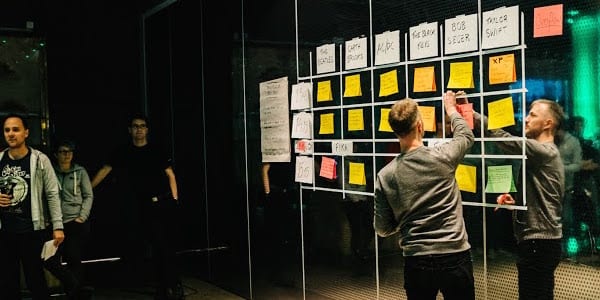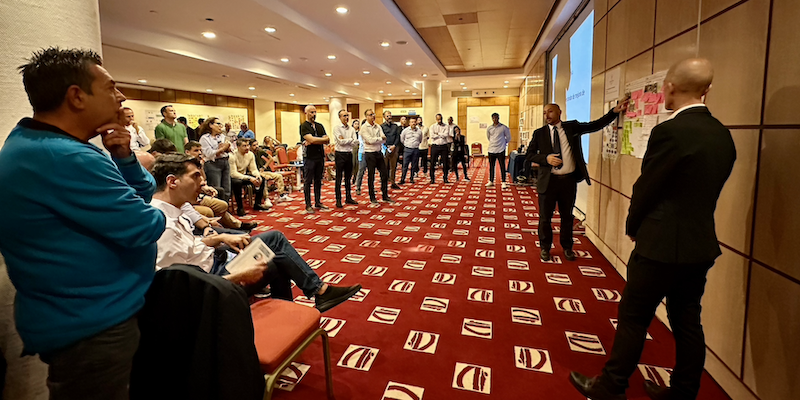
How music streaming giant Spotify stays successful
CASE STUDY - How Spotify developed an alternative management system based on servant leadership, interaction-based learning and adaptability – changing the music industry along the way.
Words: Kristian Lindwall, Agile Coach, Spotify
Spotify has been able to build lean and agile principles and practices into its culture since the very beginning.
There is no doubt that having this mindset from day one was a huge advantage for the organization: it allowed us to support our extremely fast growth by attracting the right talent and by innovating.
In the end, it all comes down to the people you have - they are our biggest asset - and it all starts with hiring. When we recruit, we look for individuals who are adaptable and comfortable working in a fast-changing environment. Like most other decisions made in the organization, the hiring process sees the active involvement of the teams. After all, they are the ones who are going to work with the new hire.
OUR STRUCTURE
Spotify employs about 1,500 people globally. About half of them directly work on the actual product (technology, design, coding, and so on) so many of you use on your laptop and mobile devices.

The smallest organized entity within Spotify is the squad, a group of usually no more than 7-9 people that sit and work together. There are around 70-80 of them within the business. Squads have a long-term mission, are self-organized and cross-functional, and possess all the tools they require to work effectively. They have been described as “mini startups” and have end-to-end responsibility for their parts of the product. Each squad has a dedicated product owner who drives product vision and ensures alignment within the squad.
A collection of squads within a business area is called a tribe. Tribes are usually somewhere between 50 and 150 people in size, sharing a habitat that is overseen by the Tribe Lead and a tribe leadership team. There are regular meetings that are used to bring everybody up to speed with the latest jobs and issues. If the squad is a mini startup, the tribe is a “mini startup incubator.”
We also recognize the importance for professionals to feel connected to others who have a similar skills set and do similar work. That’s the idea behind chapters where, say, Android developers can discuss and learn from one another. Chapters meet at regular cadence and their leaders are line managers, responsible for developing people.
The prerogative of squads is to produce value, going from idea to end product, while chapters offer support for people inside the squads.
DEVELOPING SQUADS, AND PEOPLE
We want people in squads to know one another as individuals, as well as professionals. A strong personal relationship builds trust which is key for solid teamwork. That’s why we often take them out for the day, to work on internal dynamics. We found that when people step out of their comfort zones, they open up more and form stronger connections.

During these outings, all together we delve deep into the purpose of the squad, the process, and so on – this helps us to get people engaged in not only their part of the work, but also in the squad’s contribution to Spotify’s mission.
Once people have settled in a squad, we have several approaches to developing them. One of the most effective ones is the guilds, which are essentially communities of interest and practice. People can join any guild they are interested in: for example, I am in the leadership and innovation guilds, among others. In the guilds, there is a lot of knowledge sharing and practice: they often organize unconferences on topics like continuous delivery (a few months ago, we had 100 people attending a Leadership Unconference).
We encourage the squads to grow a strong learning culture: we need people to continuously improve and grow and this is nurtured in many different ways, for example through lunch and learns, close collaboration, and cross-squad knowledge sharing.
At Spotify, people development is mostly based on interaction with skilled and likeminded colleagues, rather than on sitting in a classroom.
HOW IMPROVEMENT TAKES PLACE
When something goes wrong, we always make sure that there is a conversation about it and that action is taken. We organize retrospectives on a regular cadence at different organizational levels (within squads, tribes, in projects and so on) , the idea behind them being to learn from mistakes and successes and to understand what can be done better in the next cycle.
We also have several groups of coaches, whose role is to improve the people, squads and tribes. Are people talking to one another? Are the squads performing at a high level? How does this tribe relate to that tribe? Where are there bottlenecks in the system? These are some of the questions the coaches ask.
An initiative with a more specific scope that involves a number of squads (sometimes even from different Spotify locations) is sometimes supported by a “road manager.” This person focuses on establishing good communication channels, giving people clear context, and clarifies the vision and remit of the project. Road managers can set up cross-squad retrospectives. When squads get together, the road managers have people discuss the biggest impediments to their work and then make sure that action is taken to address those obstacles.
Basically, we apply the different ideas of agile to the different levels of the organization. Looking at the entire organizational system is the TPD Operations team, whose purpose is to help to improve everything and highlight and eliminate waste wherever we produce it.
We are aware of the importance of connecting the scope, responsibilities and goals of the different levels of the organization, which is why we have come up with a specific structure and cadence to our problem solving approach.
Squads will have a constant dialogue on what they are doing and the value they are producing, and the issues, opportunities and reflections identified during these conversations are regularly brought to the tribes.
Every couple of months, representatives of the tribes and different parts of the organization meet for a few days to discuss strategy and long-term planning. By this time, we have gathered everybody’s point of view. Additionally, the CEO and other senior leaders will participate in these “strategy days,” offering their input.
This is one of the ways in which we create alignment and agreement on the priorities and mission for the business going forward. These priorities are then brought back to the tribes, which then figure out what contribution they can give.
A DIFFERENT TYPE OF LEADERSHIP
The reporting structure is upside down here at Spotify: people are supported by leaders, not the other way around. We don’t tell them what to do, but help them to help us to figure out what the company needs to do next. This is the core mindset that reflects itself in our model, commonly known as servant leadership.

The autonomy of the teams is one of the main features of teamwork here: squads are product-focused, have technical knowledge (all the needed skills are present) and benefit from agile collaboration.
In squads and chapters leadership plays a critical role, and decisions are made collegially. Every team has a Product Owner (the primary link between the squad and the business), one or several Chapter leads (who support the individual contributors in the squad with coaching and mentoring), and an Agile Coach (whose role is to ensure the team improves and works in a healthy and collaborative environment where people are engaged in improving the product).
These three roles form a type of leadership team for the squads, which we call POTLACS. This team typically sits with the squad and meets on a weekly basis to discuss progress: sometimes this is a short chat, but when problems arise it can easily become a longer conversation.
We try to avoid the scrum textbook approach of the product owner owning the agenda and providing answers to the team: instead, at Spotify we encourage team members to get involved with the strategy, while making sure the squad is on the right track.
Accountability is shared between the members of each squad’s leadership team. Internal to the squads, decision-making is carried out together too. The squad will constantly question how a decision will influence the product, something that traditional businesses will normally ask themselves higher up in the company structure.
Formal leadership structures are there to support and enable the squads to make decisions, be effective and to help them align with the company’s priorities.
INJECTING FLEXIBILITY IN THE WORK
We have different types of squads, carrying out different types of work. Feature squads tackle individual features/functions of the product (the Artist squad, for example, will focus on creating a great experience for the artists sharing their music on Spotify). Other types include: the container squads (their focus is to work on the platform hosting our technology, like iOS) and the infrastructure squads (that look into back-end functions, like data storage).
When we take on a new project, ideally we would want one squad to be able to autonomously deliver on it. However, there are times when a number of squads must be involved. In this case, we have a few options: we can create a new squad from scratch (pulling one member from other squads until the project is completed), tweak an existing one, or support several squads to collaborate. In general, we do not want to mess around too much with squads, because a change in the setup of a squad will hold the group back in their move towards a higher performance.
It is a great advantage to us to have such a flexible system.
BEING CONNECTED TO THE USER
From a product perspective, competition for Spotify is increasing substantially. The system we have in place keeps us very adaptable to changing circumstances, and our focus on the customer ensures we remain competitive in the marketplace.
We are constantly connected to customers, carrying out a lot of user testing and research, but also focusing on data and analytics. We are in a good position, because we are very close to the end user: continuous delivery means we can develop a feature, deploy it to 1,000 people, see how it is received, talk to people, take it back and make the necessary adjustments.
At Spotify, we walk the talk. We live lean and agile values, which are at the core of our success as an organization. We push decision making as close to where work happens as possible; we remove politics, bureaucracy and waste whenever they appear; and we keep as close as we can to the user.
THE AUTHOR

Read more


FEATURE – The planet is warming at an unsustainable rate, pollution is increasing, wildlife populations and arable land areas have plummeted, and our oceans are filling with plastic. Can Lean Thinking help?


BOOK EXCERPT – These are the opening paragraphs of Chapter 1 of the new Lean Global Network book about applying Lean Thinking in a resort hotel.


FEATURE – Our editor attends a Lean Day at Dreamplace Hotels & Resorts in Tenerife. In this report, he shares his thoughts about team building, following up on improvements, and yokoten.


COLUMN – Digitalization is now on the agenda of executive teams and is encouraging organizations to review their business models. But how does IT fit into the picture? What is its role? How can lean help?

